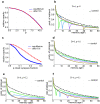Stochastic consolidation of lifelong memory
- PMID: 35907920
- PMCID: PMC9339009
- DOI: 10.1038/s41598-022-16407-9
Stochastic consolidation of lifelong memory
Abstract
Humans have the remarkable ability to continually store new memories, while maintaining old memories for a lifetime. How the brain avoids catastrophic forgetting of memories due to interference between encoded memories is an open problem in computational neuroscience. Here we present a model for continual learning in a recurrent neural network combining Hebbian learning, synaptic decay and a novel memory consolidation mechanism: memories undergo stochastic rehearsals with rates proportional to the memory's basin of attraction, causing self-amplified consolidation. This mechanism gives rise to memory lifetimes that extend much longer than the synaptic decay time, and retrieval probability of memories that gracefully decays with their age. The number of retrievable memories is proportional to a power of the number of neurons. Perturbations to the circuit model cause temporally-graded retrograde and anterograde deficits, mimicking observed memory impairments following neurological trauma.
© 2022. The Author(s).
Conflict of interest statement
The authors declare no competing interests.
Figures








Similar articles
-
Can sleep protect memories from catastrophic forgetting?Elife. 2020 Aug 4;9:e51005. doi: 10.7554/eLife.51005. Elife. 2020. PMID: 32748786 Free PMC article.
-
Hebbian plasticity in parallel synaptic pathways: A circuit mechanism for systems memory consolidation.PLoS Comput Biol. 2021 Dec 7;17(12):e1009681. doi: 10.1371/journal.pcbi.1009681. eCollection 2021 Dec. PLoS Comput Biol. 2021. PMID: 34874938 Free PMC article.
-
Lifelong Learning With Cycle Memory Networks.IEEE Trans Neural Netw Learn Syst. 2024 Nov;35(11):16439-16452. doi: 10.1109/TNNLS.2023.3294495. Epub 2024 Oct 29. IEEE Trans Neural Netw Learn Syst. 2024. PMID: 37506014
-
Possible role of intramembrane receptor-receptor interactions in memory and learning via formation of long-lived heteromeric complexes: focus on motor learning in the basal ganglia.J Neural Transm Suppl. 2003;(65):1-28. doi: 10.1007/978-3-7091-0643-3_1. J Neural Transm Suppl. 2003. PMID: 12946046 Review.
-
Continual lifelong learning with neural networks: A review.Neural Netw. 2019 May;113:54-71. doi: 10.1016/j.neunet.2019.01.012. Epub 2019 Feb 6. Neural Netw. 2019. PMID: 30780045 Review.
Cited by
-
Formation of an expanding memory representation in the hippocampus.Nat Neurosci. 2025 Jul;28(7):1510-1518. doi: 10.1038/s41593-025-01986-3. Epub 2025 Jun 4. Nat Neurosci. 2025. PMID: 40467863 Free PMC article.
-
Brain serotonergic fibers suggest anomalous diffusion-based dropout in artificial neural networks.Front Neurosci. 2022 Oct 4;16:949934. doi: 10.3389/fnins.2022.949934. eCollection 2022. Front Neurosci. 2022. PMID: 36267232 Free PMC article.
-
A dynamic attractor network model of memory formation, reinforcement and forgetting.PLoS Comput Biol. 2023 Dec 20;19(12):e1011727. doi: 10.1371/journal.pcbi.1011727. eCollection 2023 Dec. PLoS Comput Biol. 2023. PMID: 38117859 Free PMC article.
-
Attractor neural networks with double well synapses.PLoS Comput Biol. 2024 Feb 7;20(2):e1011354. doi: 10.1371/journal.pcbi.1011354. eCollection 2024 Feb. PLoS Comput Biol. 2024. PMID: 38324630 Free PMC article.
-
Selective consolidation of learning and memory via recall-gated plasticity.Elife. 2024 Jul 18;12:RP90793. doi: 10.7554/eLife.90793. Elife. 2024. PMID: 39023518 Free PMC article.
References
-
- Rubin DC. On the retention function for autobiographical memory. J. Verbal Learn. Verbal Behav. 1982;21:21–38. doi: 10.1016/S0022-5371(82)90423-6. - DOI
-
- Averell L, Heathcote A. The form of the forgetting curve and the fate of memories. J. Math. Psychol. 2011;55:25–35. doi: 10.1016/j.jmp.2010.08.009. - DOI
Publication types
MeSH terms
LinkOut - more resources
Full Text Sources
Medical

